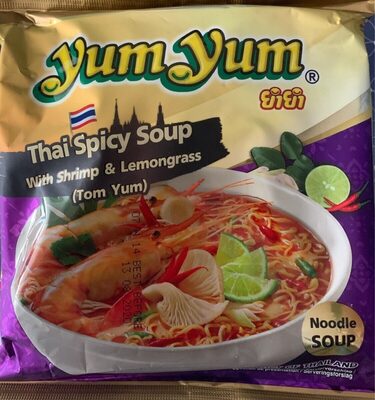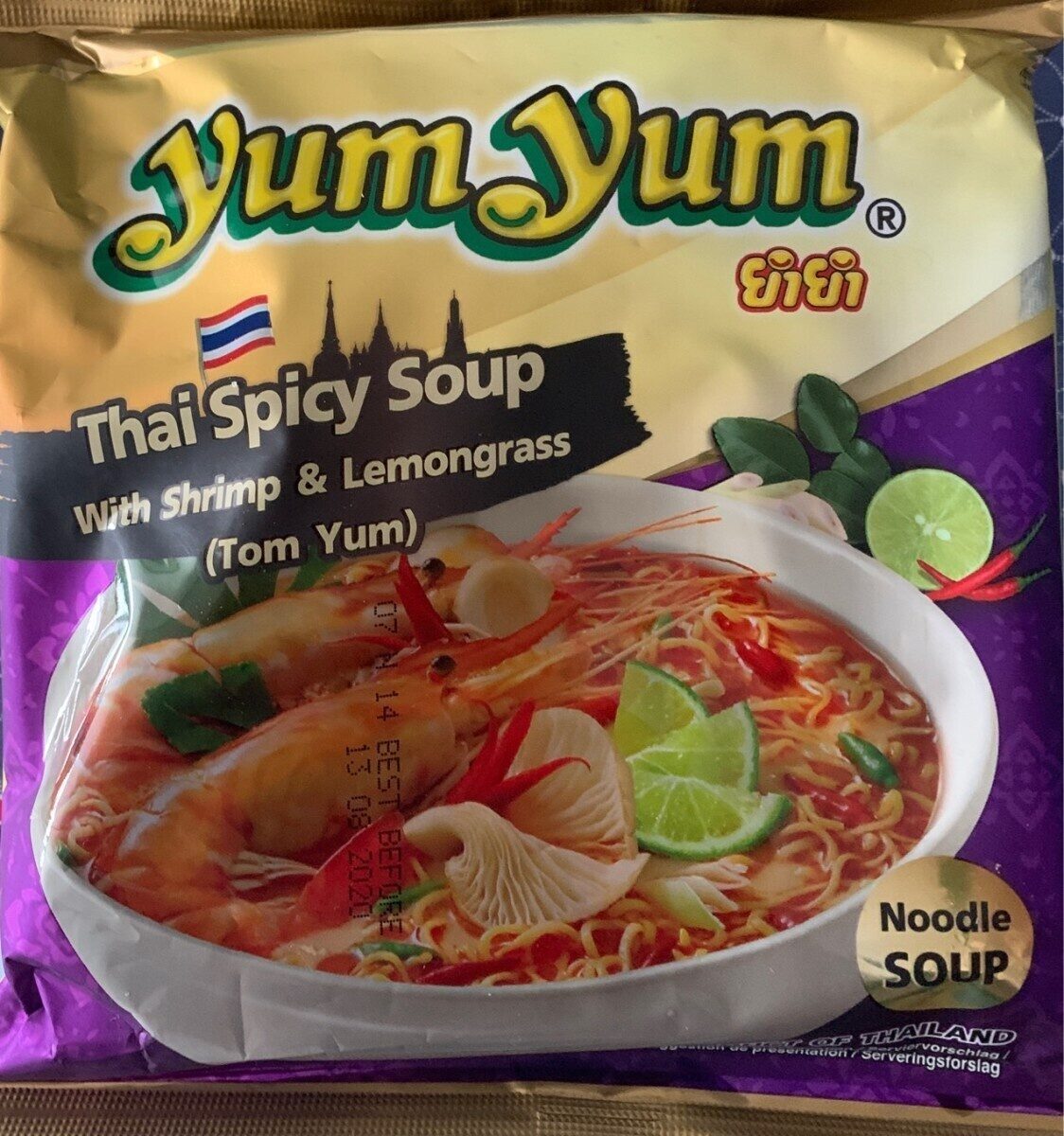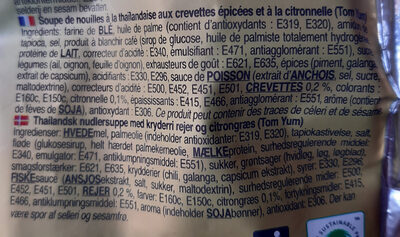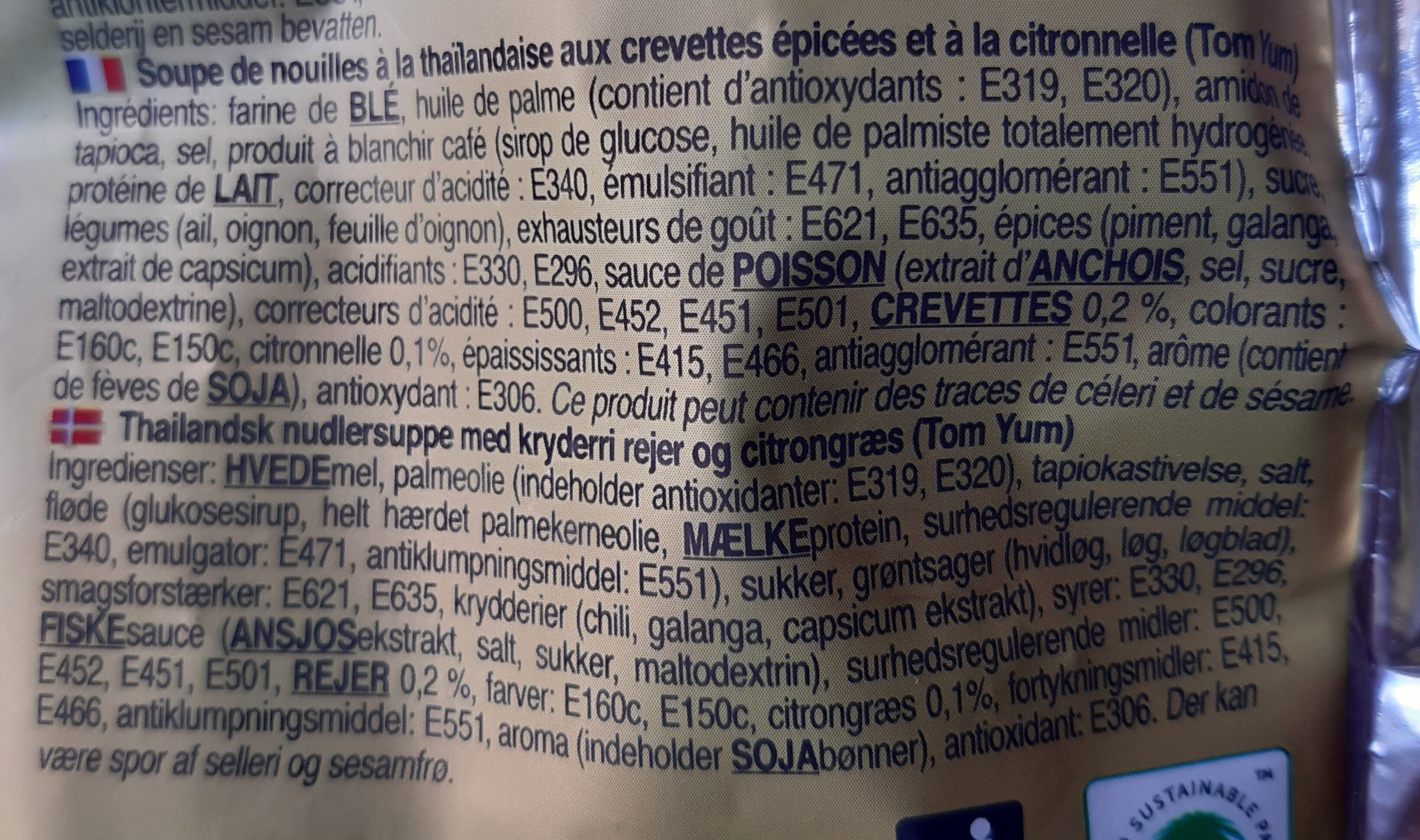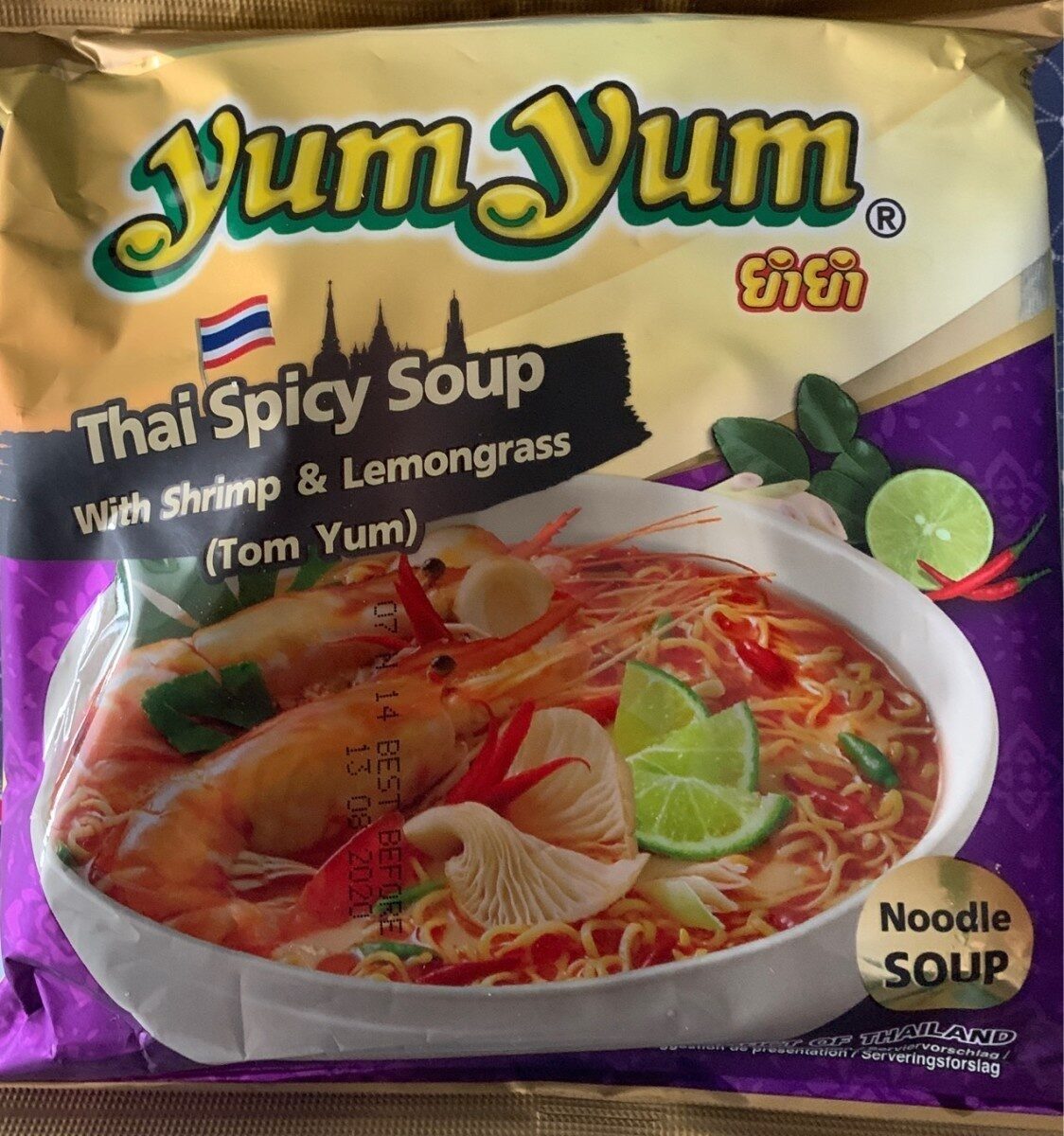Help us make food transparency the norm!
As a non-profit organization, we depend on your donations to continue informing consumers around the world about what they eat.
The food revolution starts with you!
Thai Spicy Soup - Yum Yum - 100g
Thai Spicy Soup - Yum Yum - 100g
This product page is not complete. You can help to complete it by editing it and adding more data from the photos we have, or by taking more photos using the app for Android or iPhone/iPad. Thank you!
×
Barcode: 8852018800026 (EAN / EAN-13)
Common name: Soupe Thaïlandaise Crevette et Citronnelle
Quantity: 100g
Packaging: Plastic
Brands: Yum Yum
Categories: Plant-based foods and beverages, Plant-based foods, Meals, Dried products, Pastas, Dried products to be rehydrated, Noodles, Soups, Dried meals, Instant noodles, Instant noodle soups
Manufacturing or processing places: Thailand
Stores: Leclerc
Countries where sold: France
Matching with your preferences
Health
Ingredients
-
55 ingredients
French: farine de BLÉ, huile de palme (contient d'antioxydants : E319, E320), amidon de tapioca, sel, produit à blanchir café (sirop de glucose, huile de palmiste totalement hydrogénée, protéine de LAIT, correcteur d'acidite : E340, ẻmulsifiant : E471, antiagglomérant : E551), sucre, légumes (ail, oignon, feuille d'oignon), exhausteurs de goût : E621, E635, épices (piment, galanga extrait de capsicum), acidifiants: E330, E296, sauce de POISSON (extrait d'ANCHOIS, sel, sucre, maltodextrine), correcteurs d'acidité : E500, E452, E451, E501, CREVETTES 0,2 %, colorants: E160c, E150c, citronnelle 0,1%, épaississants : E415, E466, antiagglomérant: E551, arôme (contient de fèves de SOJA), antioxydant : E306.Allergens: Crustaceans, Fish, Gluten, Milk, SoybeansTraces: Celery, Sesame seeds
Food processing
-
Ultra processed foods
Elements that indicate the product is in the 4 - Ultra processed food and drink products group:
- Additive: E150c - Ammonia caramel
- Additive: E160c - Paprika extract
- Additive: E415 - Xanthan gum
- Additive: E451 - Triphosphates
- Additive: E452 - Polyphosphates
- Additive: E466 - Sodium carboxy methyl cellulose
- Additive: E471 - Mono- and diglycerides of fatty acids
- Additive: E551 - Silicon dioxide
- Additive: E621 - Monosodium glutamate
- Additive: E635 - Disodium 5'-ribonucleotide
- Ingredient: Colour
- Ingredient: Flavour enhancer
- Ingredient: Flavouring
- Ingredient: Glucose
- Ingredient: Glucose syrup
- Ingredient: Maltodextrin
- Ingredient: Milk proteins
- Ingredient: Thickener
Food products are classified into 4 groups according to their degree of processing:
- Unprocessed or minimally processed foods
- Processed culinary ingredients
- Processed foods
- Ultra processed foods
The determination of the group is based on the category of the product and on the ingredients it contains.
Additives
-
E296 - Malic acid
Malic acid: Malic acid is an organic compound with the molecular formula C4H6O5. It is a dicarboxylic acid that is made by all living organisms, contributes to the pleasantly sour taste of fruits, and is used as a food additive. Malic acid has two stereoisomeric forms -L- and D-enantiomers-, though only the L-isomer exists naturally. The salts and esters of malic acid are known as malates. The malate anion is an intermediate in the citric acid cycle.Source: Wikipedia
-
E319 - Tertiary-butylhydroquinone (tbhq)
Tert-Butylhydroquinone: tert-Butylhydroquinone -TBHQ, tertiary butylhydroquinone- is a synthetic aromatic organic compound which is a type of phenol. It is a derivative of hydroquinone, substituted with a tert-butyl group.Source: Wikipedia
-
E320 - Butylated hydroxyanisole (bha)
Butylated hydroxyanisole: Butylated hydroxyanisole -BHA- is an antioxidant consisting of a mixture of two isomeric organic compounds, 2-tert-butyl-4-hydroxyanisole and 3-tert-butyl-4-hydroxyanisole. It is prepared from 4-methoxyphenol and isobutylene. It is a waxy solid used as a food additive with the E number E320. The primary use for BHA is as an antioxidant and preservative in food, food packaging, animal feed, cosmetics, rubber, and petroleum products. BHA also is commonly used in medicines, such as isotretinoin, lovastatin, and simvastatin, among others.Source: Wikipedia
-
E330 - Citric acid
Citric acid is a natural organic acid found in citrus fruits such as lemons, oranges, and limes.
It is widely used in the food industry as a flavor enhancer, acidulant, and preservative due to its tart and refreshing taste.
Citric acid is safe for consumption when used in moderation and is considered a generally recognized as safe (GRAS) food additive by regulatory agencies worldwide.
-
E340 - Potassium phosphates
Potassium phosphate: Potassium phosphate is a generic term for the salts of potassium and phosphate ions including: Monopotassium phosphate -KH2PO4- -Molar mass approx: 136 g/mol- Dipotassium phosphate -K2HPO4- -Molar mass approx: 174 g/mol- Tripotassium phosphate -K3PO4- -Molar mass approx: 212.27 g/mol-As food additives, potassium phosphates have the E number E340.Source: Wikipedia
-
E415 - Xanthan gum
Xanthan gum (E415) is a natural polysaccharide derived from fermented sugars, often used in the food industry as a thickening and stabilizing agent.
This versatile food additive enhances texture and prevents ingredient separation in a wide range of products, including salad dressings, sauces, and gluten-free baked goods.
It is considered safe for consumption even at high intake amounts.
-
E451 - Triphosphates
Sodium triphosphate: Sodium triphosphate -STP-, also sodium tripolyphosphate -STPP-, or tripolyphosphate -TPP-,- is an inorganic compound with formula Na5P3O10. It is the sodium salt of the polyphosphate penta-anion, which is the conjugate base of triphosphoric acid. It is produced on a large scale as a component of many domestic and industrial products, especially detergents. Environmental problems associated with eutrophication are attributed to its widespread use.Source: Wikipedia
-
E466 - Sodium carboxy methyl cellulose
Carboxymethyl cellulose: Carboxymethyl cellulose -CMC- or cellulose gum or tylose powder is a cellulose derivative with carboxymethyl groups --CH2-COOH- bound to some of the hydroxyl groups of the glucopyranose monomers that make up the cellulose backbone. It is often used as its sodium salt, sodium carboxymethyl cellulose.Source: Wikipedia
-
E471 - Mono- and diglycerides of fatty acids
Mono- and diglycerides of fatty acids (E471), are food additives commonly used as emulsifiers in various processed foods.
These compounds consist of glycerol molecules linked to one or two fatty acid chains, which help stabilize and blend water and oil-based ingredients. E471 enhances the texture and shelf life of products like margarine, baked goods, and ice cream, ensuring a smooth and consistent texture.
It is generally considered safe for consumption within established regulatory limits.
-
E500 - Sodium carbonates
Sodium carbonates (E500) are compounds commonly used in food preparation as leavening agents, helping baked goods rise by releasing carbon dioxide when they interact with acids.
Often found in baking soda, they regulate the pH of food, preventing it from becoming too acidic or too alkaline. In the culinary world, sodium carbonates can also enhance the texture and structure of foods, such as noodles, by modifying the gluten network.
Generally recognized as safe, sodium carbonates are non-toxic when consumed in typical amounts found in food.
-
E501 - Potassium carbonates
Potassium carbonate: Potassium carbonate -K2CO3- is a white salt, which is soluble in water -insoluble in ethanol- and forms a strongly alkaline solution. It can be made as the product of potassium hydroxide's absorbent reaction with carbon dioxide. It is deliquescent, often appearing a damp or wet solid. Potassium carbonate is used in the production of soap and glass.Source: Wikipedia
-
E551 - Silicon dioxide
Silicon dioxide: Silicon dioxide, also known as silica, silicic acid or silicic acid anydride is an oxide of silicon with the chemical formula SiO2, most commonly found in nature as quartz and in various living organisms. In many parts of the world, silica is the major constituent of sand. Silica is one of the most complex and most abundant families of materials, existing as a compound of several minerals and as synthetic product. Notable examples include fused quartz, fumed silica, silica gel, and aerogels. It is used in structural materials, microelectronics -as an electrical insulator-, and as components in the food and pharmaceutical industries. Inhaling finely divided crystalline silica is toxic and can lead to severe inflammation of the lung tissue, silicosis, bronchitis, lung cancer, and systemic autoimmune diseases, such as lupus and rheumatoid arthritis. Uptake of amorphous silicon dioxide, in high doses, leads to non-permanent short-term inflammation, where all effects heal.Source: Wikipedia
-
E621 - Monosodium glutamate
Monosodium glutamate: Monosodium glutamate -MSG, also known as sodium glutamate- is the sodium salt of glutamic acid, one of the most abundant naturally occurring non-essential amino acids. Glutamic acid is found naturally in tomatoes, grapes, cheese, mushrooms and other foods.MSG is used in the food industry as a flavor enhancer with an umami taste that intensifies the meaty, savory flavor of food, as naturally occurring glutamate does in foods such as stews and meat soups. It was first prepared in 1908 by Japanese biochemist Kikunae Ikeda, who was trying to isolate and duplicate the savory taste of kombu, an edible seaweed used as a base for many Japanese soups. MSG as a flavor enhancer balances, blends, and rounds the perception of other tastes.The U.S. Food and Drug Administration has given MSG its generally recognized as safe -GRAS- designation. A popular belief is that large doses of MSG can cause headaches and other feelings of discomfort, known as "Chinese restaurant syndrome," but double-blind tests fail to find evidence of such a reaction. The European Union classifies it as a food additive permitted in certain foods and subject to quantitative limits. MSG has the HS code 29224220 and the E number E621.Source: Wikipedia
Ingredients analysis
-
Palm oil
Ingredients that contain palm oil: Palm oil, fr:Palmiste totalement hydrogénée
-
Non-vegan
Non-vegan ingredients: Milk proteins, Fish sauce, Anchovy, ShrimpSome ingredients could not be recognized.
We need your help!
You can help us recognize more ingredients and better analyze the list of ingredients for this product and others:
- Edit this product page to correct spelling mistakes in the ingredients list, and/or to remove ingredients in other languages and sentences that are not related to the ingredients.
- Add new entries, synonyms or translations to our multilingual lists of ingredients, ingredient processing methods, and labels.
If you would like to help, join the #ingredients channel on our Slack discussion space and/or learn about ingredients analysis on our wiki. Thank you!
-
Non-vegetarian
Non-vegetarian ingredients: Fish sauce, Anchovy, ShrimpSome ingredients could not be recognized.
We need your help!
You can help us recognize more ingredients and better analyze the list of ingredients for this product and others:
- Edit this product page to correct spelling mistakes in the ingredients list, and/or to remove ingredients in other languages and sentences that are not related to the ingredients.
- Add new entries, synonyms or translations to our multilingual lists of ingredients, ingredient processing methods, and labels.
If you would like to help, join the #ingredients channel on our Slack discussion space and/or learn about ingredients analysis on our wiki. Thank you!
-
Details of the analysis of the ingredients
We need your help!
Some ingredients could not be recognized.
We need your help!
You can help us recognize more ingredients and better analyze the list of ingredients for this product and others:
- Edit this product page to correct spelling mistakes in the ingredients list, and/or to remove ingredients in other languages and sentences that are not related to the ingredients.
- Add new entries, synonyms or translations to our multilingual lists of ingredients, ingredient processing methods, and labels.
If you would like to help, join the #ingredients channel on our Slack discussion space and/or learn about ingredients analysis on our wiki. Thank you!
fr: farine de BLÉ, huile de palme (contient d'antioxydants (e319), e320), amidon de tapioca, sel, produit à blanchir café (sirop de glucose, huile de palmiste totalement hydrogénée, protéine de LAIT, correcteur d'acidite (e340), ẻmulsifiant (e471), antiagglomérant (e551)), sucre, légumes (ail, oignon, oignon), exhausteurs de goût (e621), e635, épices (piment, galanga extrait de capsicum), acidifiants (e330), e296, sauce de POISSON (ANCHOIS, sel, sucre, maltodextrine), correcteurs d'acidité (e500), e452, e451, e501, CREVETTES 0.2%, colorants (e160c), e150c, citronnelle 0.1%, épaississants (e415), e466, antiagglomérant (e551), arôme (contient de fèves de SOJA), antioxydant (e306)- farine de BLÉ -> en:wheat-flour - vegan: yes - vegetarian: yes - ciqual_proxy_food_code: 9410
- huile de palme -> en:palm-oil - vegan: yes - vegetarian: yes - from_palm_oil: yes - ciqual_food_code: 16129
- contient d'antioxydants -> en:antioxidant
- e319 -> en:e319 - vegan: yes - vegetarian: yes
- e320 -> en:e320 - vegan: yes - vegetarian: yes
- contient d'antioxydants -> en:antioxidant
- amidon de tapioca -> en:tapioca - vegan: yes - vegetarian: yes - ciqual_proxy_food_code: 9510
- sel -> en:salt - vegan: yes - vegetarian: yes - ciqual_food_code: 11058
- produit à blanchir café -> fr:produit-a-blanchir-cafe
- sirop de glucose -> en:glucose-syrup - vegan: yes - vegetarian: yes - ciqual_proxy_food_code: 31016
- huile de palmiste totalement hydrogénée -> fr:palmiste-totalement-hydrogenee - vegan: yes - vegetarian: yes - from_palm_oil: yes
- protéine de LAIT -> en:milk-proteins - vegan: no - vegetarian: yes
- correcteur d'acidite -> en:acidity-regulator
- e340 -> en:e340 - vegan: yes - vegetarian: yes
- ẻmulsifiant -> fr:ẻmulsifiant
- e471 -> en:e471 - vegan: maybe - vegetarian: maybe - from_palm_oil: maybe
- antiagglomérant -> en:anti-caking-agent
- e551 -> en:e551 - vegan: yes - vegetarian: yes
- sucre -> en:sugar - vegan: yes - vegetarian: yes - ciqual_proxy_food_code: 31016
- légumes -> en:vegetable - vegan: yes - vegetarian: yes
- ail -> en:garlic - vegan: yes - vegetarian: yes - ciqual_food_code: 11000
- oignon -> en:onion - vegan: yes - vegetarian: yes - ciqual_food_code: 20034
- oignon -> en:onion - vegan: yes - vegetarian: yes - ciqual_food_code: 20034
- exhausteurs de goût -> en:flavour-enhancer
- e621 -> en:e621 - vegan: yes - vegetarian: yes
- e635 -> en:e635 - vegan: maybe - vegetarian: maybe
- épices -> en:spice - vegan: yes - vegetarian: yes
- piment -> en:chili-pepper - vegan: yes - vegetarian: yes - ciqual_food_code: 20151
- galanga extrait de capsicum -> fr:galanga-extrait-de-capsicum
- acidifiants -> en:acid
- e330 -> en:e330 - vegan: yes - vegetarian: yes
- e296 -> en:e296 - vegan: yes - vegetarian: yes
- sauce de POISSON -> en:fish-sauce - vegan: no - vegetarian: no
- ANCHOIS -> en:anchovy - vegan: no - vegetarian: no - ciqual_food_code: 26079
- sel -> en:salt - vegan: yes - vegetarian: yes - ciqual_food_code: 11058
- sucre -> en:sugar - vegan: yes - vegetarian: yes - ciqual_proxy_food_code: 31016
- maltodextrine -> en:maltodextrin - vegan: yes - vegetarian: yes
- correcteurs d'acidité -> en:acidity-regulator
- e500 -> en:e500 - vegan: yes - vegetarian: yes
- e452 -> en:e452 - vegan: yes - vegetarian: yes
- e451 -> en:e451 - vegan: yes - vegetarian: yes
- e501 -> en:e501 - vegan: yes - vegetarian: yes
- CREVETTES -> en:shrimp - vegan: no - vegetarian: no - ciqual_food_code: 10021 - percent: 0.2
- colorants -> en:colour
- e160c -> en:e160c - vegan: yes - vegetarian: yes
- e150c -> en:e150a - vegan: yes - vegetarian: yes
- citronnelle -> en:lemongrass - vegan: yes - vegetarian: yes - percent: 0.1
- épaississants -> en:thickener
- e415 -> en:e415 - vegan: yes - vegetarian: yes
- e466 -> en:e466 - vegan: yes - vegetarian: yes
- antiagglomérant -> en:anti-caking-agent
- e551 -> en:e551 - vegan: yes - vegetarian: yes
- arôme -> en:flavouring - vegan: maybe - vegetarian: maybe
- contient de fèves de SOJA -> en:soya-bean - vegan: yes - vegetarian: yes - ciqual_food_code: 20901
- antioxydant -> en:antioxidant
- e306 -> en:e306 - vegan: yes - vegetarian: yes
-
Nutrition facts
Nutrition facts As sold
for 100 g / 100 mlCompared to: Instant noodle soups Energy 436 kj
(104 kcal)-61% Fat 5.2 g -46% Saturated fat 2.4 g -40% Carbohydrates 13 g -66% Sugars 1.4 g -35% Fiber 6.3 g +275% Proteins 1.5 g -74% Salt 0 g -100% Fruits‚ vegetables‚ nuts and rapeseed‚ walnut and olive oils (estimate from ingredients list analysis) 0.83 %
Environment
-
Eco-Score C - Moderate environmental impact
⚠ ️Select a country in order to include the full impact of transportation.The Eco-Score is an experimental score that summarizes the environmental impacts of food products.→ The Eco-Score was initially developped for France and it is being extended to other European countries. The Eco-Score formula is subject to change as it is regularly improved to make it more precise and better suited to each country.Life cycle analysis
-
Average impact of products of the same category: B (Score: 66/100)
Category: Soup, Asian-style with noodles, prepacked, to be reheated
Category: Soup, Asian-style with noodles, prepacked, to be reheated
- PEF environmental score: 0.38 (the lower the score, the lower the impact)
- including impact on climate change: 3.15 kg CO2 eq/kg of product
Stage Impact Agriculture
59.3 %Processing
25.0 %Packaging
2.6 %Transportation
10.7 %Distribution
1.2 %Consumption
1.1 %
Bonuses and maluses
-
Missing origins of ingredients information
Malus: -5
⚠ ️ The origins of the ingredients of this product are not indicated.
If they are indicated on the packaging, you can modify the product sheet and add them.
If you are the manufacturer of this product, you can send us the information with our free platform for producers.
-
Ingredients that threatens species
Malus: -10
Contains palm oil
Tropical forests in Asia, Africa and Latin America are destroyed to create and expand oil palm tree plantations. The deforestation contributes to climate change, and it endangers species such as the orangutan, the pigmy elephant and the Sumatran rhino.
-
Packaging with a medium impact
Malus: -10
Shape Material Recycling Impact Unknown Plastic High ⚠ ️ The information about the packaging of this product is not sufficiently precise (exact shapes and materials of all components of the packaging).⚠ ️ For a more precise calculation of the Eco-Score, you can modify the product page and add them.
If you are the manufacturer of this product, you can send us the information with our free platform for producers.
Eco-Score for this product
-
Impact for this product: C (Score: 41/100)
Product: Thai Spicy Soup - Yum Yum - 100g
Life cycle analysis score: 66
Sum of bonuses and maluses: -25
Final score: 41/100
-
Carbon footprint
-
Equal to driving 1.6 km in a petrol car
315 g CO² per 100g of product
The carbon emission figure comes from ADEME's Agribalyse database, for the category: Soup, Asian-style with noodles, prepacked, to be reheated (Source: ADEME Agribalyse Database)
Stage Impact Agriculture
62.1 %Processing
19.1 %Packaging
3.2 %Transportation
14.7 %Distribution
0.5 %Consumption
0.4 %
Packaging
-
Packaging with a medium impact
-
Packaging parts
(Plastic)
-
Packaging materials
Material % Packaging weight Packaging weight per 100 g of product Plastic
-
Transportation
-
Origins of ingredients
Missing origins of ingredients information
⚠ ️ The origins of the ingredients of this product are not indicated.
If they are indicated on the packaging, you can modify the product sheet and add them.
If you are the manufacturer of this product, you can send us the information with our free platform for producers.Add the origins of ingredients for this product Add the origins of ingredients for this product
Threatened species
-
Contains palm oil
Drives deforestation and threatens species such as the orangutan
Tropical forests in Asia, Africa and Latin America are destroyed to create and expand oil palm tree plantations. The deforestation contributes to climate change, and it endangers species such as the orangutan, the pigmy elephant and the Sumatran rhino.
Report a problem
-
Incomplete or incorrect information?
Category, labels, ingredients, allergens, nutritional information, photos etc.
If the information does not match the information on the packaging, please complete or correct it. Open Food Facts is a collaborative database, and every contribution is useful for all.
Data sources
Product added on by kiliweb
Last edit of product page on by kiliweb.
Product page also edited by ecoscore-impact-estimator, openfoodfacts-contributors, packbot, pylm95, roboto-app, tiphainelhuillier, yuka.WFBnbURLTVR0cUZVc3NRZitCZUt4K2hSM1kyZ2JEKzdBc00xSVE9PQ, yuka.sY2b0xO6T85zoF3NwEKvlmUaTOPFuyv4HjHvgXHT1v6fAcO2Y_Fu76XlHqs, yuka.sY2b0xO6T85zoF3NwEKvlmkdScXYnW7ILyffm2qnxs3VKrWwX9VC47ToEas, yuka.sY2b0xO6T85zoF3NwEKvlnwabtWFrBDLJgLls0up-_qoJazMRclg3bGhKKs.
